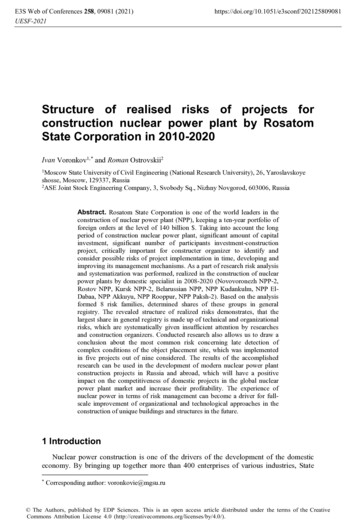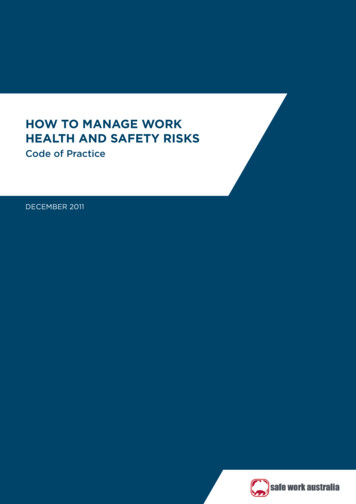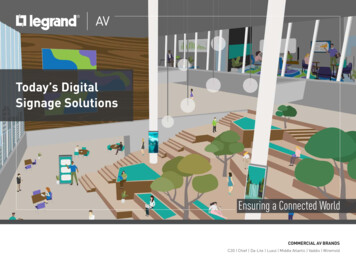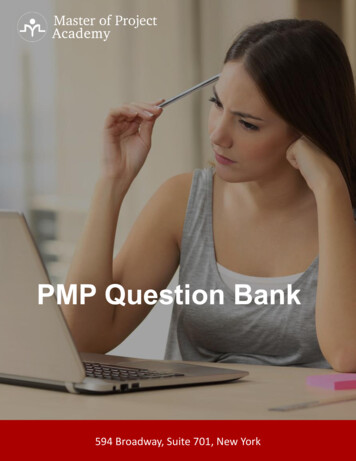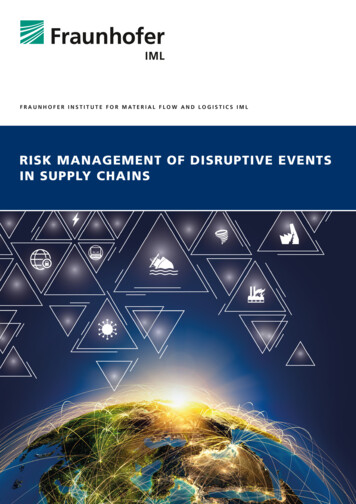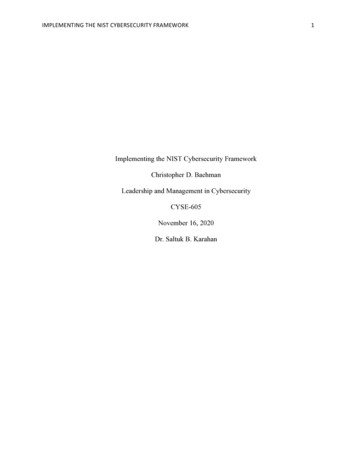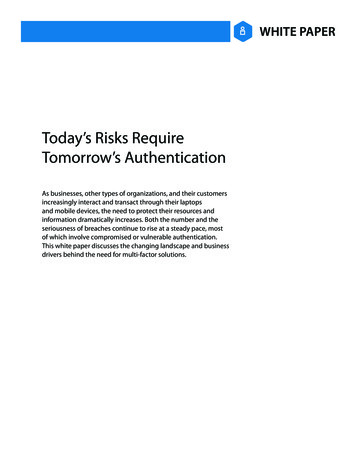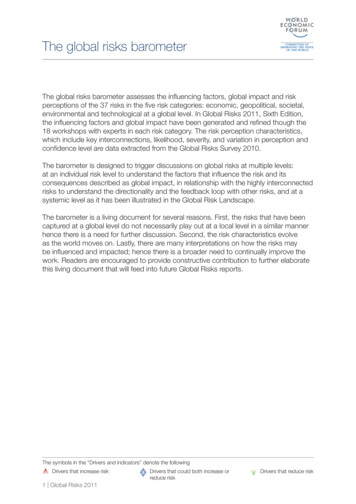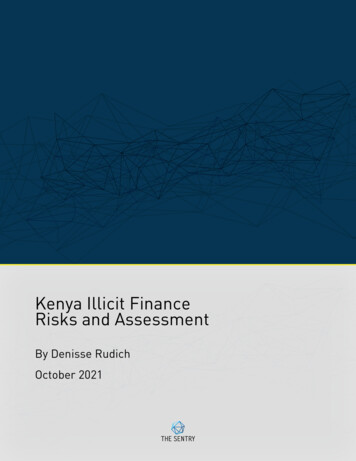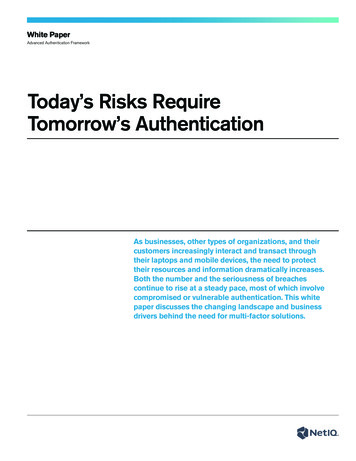
Transcription
White PaperAdvanced Authentication FrameworkToday’s Risks RequireTomorrow’s AuthenticationAs businesses, other types of organizations, and theircustomers increasingly interact and transact throughtheir laptops and mobile devices, the need to protecttheir resources and information dramatically increases.Both the number and the seriousness of breachescontinue to rise at a steady pace, most of which involvecompromised or vulnerable authentication. This whitepaper discusses the changing landscape and businessdrivers behind the need for multi-factor solutions.
Table of ContentspageResponding to Today’s Security Threats. . . . . . . . . . . . . . . . . . . . . . . . . . . . . . . . . . . . . . . . . . . . 1Today’s Breach Trend Is Clear . . . . . . . . . . . . . . . . . . . . . . . . . . . . . . . . . . . . . . . . . . . . . . . . . . . . . . 3Working within Regulated Industries . . . . . . . . . . . . . . . . . . . . . . . . . . . . . . . . . . . . . . . . . . . . . . 5The Evolution of Secure Access . . . . . . . . . . . . . . . . . . . . . . . . . . . . . . . . . . . . . . . . . . . . . . . . . . . . . 7Moving Forward . . . . . . . . . . . . . . . . . . . . . . . . . . . . . . . . . . . . . . . . . . . . . . . . . . . . . . . . . . . . . . . . . . . . 8NetIQ Advanced Authentication Framework—For Today and Tomorrow . . . . . . . . . 9About NetIQ. . . . . . . . . . . . . . . . . . . . . . . . . . . . . . . . . . . . . . . . . . . . . . . . . . . . . . . . . . . . . . . . . . . . . . . 10
Responding to Today’sSecurity ThreatsThe transformation of how people work and playcontinues to evolve towards a mobile lifestyle wherepeople don’t need to be in the office to work or at thestore to shop. In fact, according to IDC1, 1.3 billionof today’s workforce is mobile. In other words, onethird of today’s workforce works outside of the office.For many professionals, the ability to stay connected using phones and the Internetenables them to accomplish tasks, collaborate with colleagues and specialized teams, andconduct most types of business interactions. However, these same trends create points ofvulnerability for unseen criminals. The internet provides the connectivity and interconnectedsocial media platforms that result in an expansive attack surface for criminals to circumventtraditional authentication and access protections.As the continual stream of headlines shows, this new paradigm of engaging with applicationsand services beyond the corporate firewall changes the rules for how organizations managerisk and apply security. The ramifications of breaches are real and sometimes very damaging.In addition to the immediate financial cost that breaches incur, frequently customer trust islost, brand reputation is tarnished, and, in instances where regulated industries are involved,privacy rules are violated, creating additional costs and potential fines.1 www.netiq.com1
White PaperToday’s Risks Require Tomorrow’s AuthenticationNetIQ believes traditional, single-factor authentication, including username and password,is no longer a sufficient approach to protecting corporate, employee or client information.And as a result of the increasingly sophisticated attacks being levied at users andorganizations, the paradigm of protecting against unauthorized access must also evolve.Users and their devices are continuously connected and exposed to a variety of attacks.Even when users are working from inside an organization’s facilities, many of the servicesthey access no longer reside inside their firewall’s perimeter, but rather out in the cloud,allowing ubiquitous access for all, both friend and foe. Moreover, since criminals andconspirators have gotten quite good at duping people into divulging their credentials(what they know), an effective way to increase security is to leverage what they have (such asa FIDO U2F device) or what they are (such as a biometric reader). The use of these variousauthentication methods is called multi-factor authentication (MFA).If done right, combining two or more authentication methods makes it exponentially moredifficult for the bad guys to circumvent access policies, reducing the risk to the organization.This paper discusses the changing trends of howprofessionals inadvertently create risk tothe organization as they do their jobsand blend their professional andpersonal lives by consuming andsharing information. It is intendedfor individuals who are researchingand gathering information inpreparation of a proposal orbusiness case for enhancing anorganization’s authentication.This information provides a foundationfrom which an organization canmove beyond passwords and upgradethe authentication experience to a level thatincreases the security while maintaining or improvinguser convenience.2If done right, combiningtwo or more authenti cation methods makesit exponentially moredifficult for the bad guysto circumvent access policies, reducing therisk to the organization.
Users that blend theirpersonal (and often lesssecure) credentials withthose used to protectprivate corporate orcustomer informationintroduce one of today’smost challenging risks.Today’s Breach Trend Is ClearThe job of managing against risks associated with the use of traditional credentials continuesto elude IT administrators. In fact, it is more difficult than ever before because users connectto both personal and corporate services with the same device, which is often personal. If giventhe opportunity, many users would simplify life for themselves by using weak passwords orwriting them down. And even if policies exist to protect against users who would otherwiserely on simple passwords, security can still be susceptible to social engineering, intentional orotherwise. Users that blend their personal (and often less secure) credentials with those usedto protect private corporate or customer information introduce one of today’s most challengingrisks. This expands the attack surface where if one instance of the user’s credentials is compromised, it also risks exposing corporate services. Unfortunately, as seen frequently inthe press, months usually go by before victimized institutions realize the breach and alert thepublic. Regardless of the password policy implemented, if a user reuses a password across hisor her professional and personal (social) services, the risk of a breach escalates. Each securityteam needs to have a plan in place that manages the vulnerability of reused credentials acrossmultiple cloud-based systems.For environments where employees move from station to station or room to room, the pressure to share credentials increases. Credential sharing can be convenient and highly efficient and is especially prevalent in industries such as manufacturing, defense contractingand healthcare. These shortcuts may save users time, but this is at the expense of security.While healthcare clinicians often fall into this practice in environments where they movefrom patient to patient and are pressed to optimize their time, this type of situation can befound throughout many organizations—from call centers, banks and retailers, where customerinformation may be at risk, to government agencies and their contractors where all types ofsecured information are at risk.Although unseen criminals continue to raise the level of sophistication in their attacks,a report2 jointly issued by Forrester and Trend Micro notes that threats more frequently2 ts-are-internalforrester-says/www.netiq.comcome from someone inside the organization. In fact, 70 percent of the time, unauthorized access comes from someone within the organization, or a contractor working within thesecure perimeter. Although IT organizations may think first of their employees, several highprofile intrusions highlight and reinforce the problem of contractors sharing their credentials.3
White PaperToday’s Risks Require Tomorrow’s AuthenticationSince contractors are often in transition, this tends to be a more frequent problem. It’s notunheard of for contractors to focus on their specific project with the here-and-now attitudeat the expense of the security of an employer or customer with whom they don’t have a longterm relationship. But whether it’s an employee, contractor or partner, the workforce’s abilityto share accounts is shortsighted and subjects the company to undue risk.In their recent threat report 3, McAfee Labs describes a million new phishing sites createdduring this past year. The report highlights not only the rapid growth of active sites, but alsoan increase in their sophistication. Widely available digital content about potential victims’interests, activities and where they work makes it easier for phishermen to learn about andAdvanced authenticationtechnologies can be usedfor out-of-band identityvalidation to protect compromised accountsand man-in-the-middlevulnerabilities. Whenimplemented correctly,it will s ignificantly increase security for virtually all environments.more effectively attack their targets. Whether it is an email claiming to be from a friend,organization, work, or some other party with whom that person interacts, these emailsand websites look authentic enough for unfortunate users to make that click that enables akeylogger to be downloaded or invites them to divulge their credentials.User education against phishing is the single most effective step an organization can takeagainst these kinds of attacks. Antivirus and malware protection are the basic steps that everyorganization should take, but upgrading to an MFA for valued information is equally importantand should be included in the majority of organizations’ defense plans. Advanced authentication technologies can be used for out-of-band identity validation to protect compromisedaccounts and man-in-the-middle vulnerabilities. When implemented correctly, it will significantly increase security for virtually all environments.In today’s universally connected digitalworld, how much risk should anorganization be willing to take?Whether it be through usersimplementing common credentials across their workand home environments oraccount sharing, betting on asingle point of credential protectionfailure is becoming more foolish as attack mechanisms continue to increase in sophistication. Even for organizations3 reat-q2-2014.pdfthat have strict password complexity policies, their value is limited4
There is a greater liabilityfor those who fail toimplement technologiesenabling complianceto HIPAA and HealthInformation Technologyfor Economic and ClinicalHealth (HITECH) rules.when they are reused repeatedly on other websites. Recent studies4 show that more than half(55%) of adult internet users admitted that they use the same password for most, if not all,of their websites. As the consumption of cloud-based applications continues to proliferate,the chance of compromised credentials draws nearer to inevitable.Working within Regulated IndustriesWhile each organization is free to choose the level of risk they are willing to take, they don’thave the prerogative to choose which regulations they will follow. Each year, regulators setmore specific security requirements and audit more aggressively. And as the number of access breaches continues to rise, this trend is likely to continue.HealthcareRegulators significantly changed the Health Insurance Portability and Accountability Act(HIPAA) in the last several years. Privacy rules continue to become more encompassing anddetailed. There is a greater liability for those who fail to implement technologies enablingcompliance to HIPAA and Health Information Technology for Economic and Clinical Health(HITECH) rules. For example, specific consequences and accountability for violations andbreaches are now in place. And if unauthorized access of regulated patient records occurs,organizations must notify the department of Health and Human Services and their patients ofthe breach. If the breach was the result of the organization not following HIPAA or HITECHrules, regulators now require a detailed plan of how the organization will become compliant,as well as the timeline for doing so.As organizations strive to meet compliance, the Office for Civil Rights (OCR) continues tofind ways to be more effective in their auditing programs. To accomplish this, they work withauditing firms as well as the healthcare agencies themselves to implement a combination ofself-auditing and health checks.Financial4 al agencies responsible for the compliance of financial and insurance institutions established rules, guidelines and audit procedures to ensure regulated organizations aggressively manage risk. A high level of security is a foundational component for makingtransactions as secure as possible. The Federal Financial Institution Examination Council5
White PaperToday’s Risks Require Tomorrow’s Authentication(FFIEC) published rules for implementing proper authentication methodologies to match thelevel of risk involved in the transaction. FFIEC instructs IT organizations to take a risk-basedlayer of security approach in their implementation and have the ability to perform reviews ofan institution. Because of these strict rules surrounding access, advanced authentication is afundamental requirement to whatever access environment a financial institution offers.FederalIT security managers in federal agencies face increasingly complex challenges as they try tokeep up with their access control requirement. These agencies commonly have unintegratedsilos of authentication environments, each requiring their own point of administration.In addition, most of these deployments locked the federal agencies into specific brands andtypes of authentication solutions. The National Institute of Standards and Technology (NIST)issued additional publications providing concrete guidance for these Federal InformationSecurity Management Act (FISMA) mandates. They provide guidance on access controls andpermission management, both of which should be based on strong authentication. In otherwords, performing certain actions or accessing specific information requires some type ofadvanced authentication method.State and Local OrganizationsVirtually all state and local agencies rely on federal databases for information on people ofinterest. To gain access to these databases and records, agencies must comply with governmentaccess and authentication requirements. The Criminal Justice Information Services (CJIS)defines and enforces policies to ensure that their information (CJI) remains secure and protected from unauthorized access. These policies include requirements for the creation,viewing, modification, transmission, dissemination, storage and destruction of CJI data.A fairly recent change in this policy is the requirement for the use of advanced authenticationmethods when accessing this information outside of a federally approved (secure) building.As a result, this mandate affects all personnel accessing CJI from their homes or squad cars.The latest mandate has the potential to make CJI access quite difficult for state and city agencies. They often have one or more building-access infrastructures in place, but they areseldom integrated and require multiple touch administration. For many agencies, this mandatewill result in yet another authentication solution and additional point of administration.However, NetIQ Advanced Authentication Framework handles most authenticationmethods and provides a single set of policies and point of administration. NetIQ Advanced6The National Institute ofStandards and Technology(NIST) issued additionalpublications providingconcrete guidance forthese Federal InformationSecurity Management Act(FISMA) mandates.
For many organizations,the solution that offersthe widest authenticationmethods, the broadestapplication-authenticationsolutions, and the lowesttotal cost of ownershipis often going to be thebest option.Authentication Framework not only ensures authentication compliance, but also equipsorganizations with what they need to adopt different or newer authentication technology inthe future, without deploying another instance of infrastructure.The Evolution of Secure AccessWhile security is and should be the fundamental requirement when deciding on an authentication solution, convenience is just as important. In fact, the ultimate measure ofsuccess of an authentication process is how effectively the business keeps its informationsecure while preserving the ease of accessibility over time. If users abstain or procrastinatecompleting tasks or business processes because authentication and access is cumbersome,the solution in place falls short. If employees avoid using business services or look for waysto get around them using their own tools because the authentication and access experienceis complicated, productivity and security take a notable hit. Furthermore, if the selectedadvanced authentication solution is time consuming or complicated to enroll, the cost ofdeployment and training will likely keep the authentication project from being implemented.As if the problem of delivering secure access isn’t complicated enough, the standards formaking mobile access convenient have recently been raised. What was an acceptable level ofconvenience five years ago is inconvenient today. This makes delivering secure, convenientaccess that protects against attacks and threats from a highly connected world a great challenge.The same technology that connects people to services and defines what is convenient and usableis also the technology used by attackers. So when organizations think about MFA usabilityrequirements, they need to consider more than just employees—they also need to take intoaccount customers, contractors and partners. This is important because for many organizations,the solution that offers the widest authentication methods, thebroadest application-authentication solutions, and the lowesttotal cost of ownership is often going to be the best option.Mobile phones and tablets have also evolved personal interaction. People are more connected and conduct morebusiness at anytime from anywhere than ever before. As such,mobile technology has become an essential component ofthe way that professional and business communicationsand interactions occur.www.netiq.com7
White PaperToday’s Risks Require Tomorrow’s AuthenticationEnterprises now recognize that their customers expect to interact and make transactions withthem on mobile devices. Customers also expect enterprises to continue to introduce new waysto be more accessible. Organizations need to personalize the mobile experience while allowingcustomers to access an unprecedented level of private information that must be secured. Butthere is more at stake than the customer’s security. What if the customer experience pales incomparison to the competition, offering less functionality or providing a cumbersome mobileaccess experience? Complicated authentication and access experience damage the corporatebrand, reduce consumer loyalty and limit customer engagement. MFA has become more thanjust security; it has become the face of the business to the customer. This means organizationsneed to plan on adding or updating their MFA to include the latest technologies to keep thecustomer experience fresh. If this isn’t planned, organizations will experience multiple authen tication frameworks or service providers that raise the costs of solutions, add to administrationhours and create situations where inconsistent policies open the way for a breach.It’s surprising how often the roughest patch of an MFA deployment is user enrollment.If enrollment requires the user (customer, employee, contractor, partner and so on) togo through a number of steps or installations, the rollout will fail. In addition, cost of enrollment needs to be a primary consideration when researching types of authenticationmethods. And, as stated earlier, high on the list of considerations is preparing for the futureand what it may potentially offer.Moving ForwardToday’s breach trend will not abate for the foreseeable future. At the same time, IT’s control overorganizations’ vulnerabilities decreased over the years and will continue to do so. The number ofcybercriminals has exploded, and they have more weapons that are far more sophisticated thanever before. As services continue to move to the cloud, a smaller percentage of them remainsinside the corporate firewall. More people embrace bring-your-own-device (BYOD) or workoutside of the office. This means that people constantly connect to and interact with varioussocial and commerce services on the internet, which broadens their attack surface exponentially.Essentially, BYOD and mobility trends cause traditional usernames and passwords to becomeprogressively ineffective as cybercriminals continue to exploit them, as well as other typesof single-factor authentication methods. Risk to the organization continues to rise withouta reinforcement of the authentication process that confirms the user’s identity.8The number of cyber criminals has exploded,and they have more weapons that are farmore sophisticated thanever before.
NetIQ offers anopen framework that aggressively updatesas new technologiesemerge, including compatibility with FIDOU2F-based devices.NetIQ Advanced Authentication Framework—For Today and TomorrowAs you look for solutions that give you choice and flexibility for both current and futureMFA needs, NetIQ ensures that you won’t get locked into authentication silos or stuck withoutdated technology. NetIQ offers an open framework that aggressively updates as new technologies emerge, including compatibility with FIDO U2F-based devices.In addition to the MFA flexibility that NetIQ Advanced Authentication Framework offers,it also comes out-of-the-box integrated with the market leading single sign-on solution fromNetIQ, which covers virtually all applications and most platforms: NetIQ Access Manager ,NetIQ CloudAccess and NetIQ SecureLogin. Having a robust single sign-on solution is anessential element of convenient access by delivering access to all the user’s relevant services.For ubiquitous compatibility, NetIQ Advanced Authentication Framework also integrateswith other single sign-on solutions.To learn more about NetIQ Advanced Authentication Framework, or to start a trial, go om9
www.netiq.comAbout NetIQNetIQ is a global, IT enterprise software company with relentless focus on customer success. Customers and partners choose NetIQ to cost-effectively tackle informationprotection challenges and manage the complexity of dynamic, highly distributed business applications.Our portfolio includes scalable, automated solutions for Identity, Security andGovernance, and IT Operations Management that help organizations securelydeliver, measure, and manage computing services across physical, virtual, and cloudcomputing environments. These solutions and our practical, customer-focused approach to solving persistent IT challenges ensure organizations are able toreduce cost, complexity and risk.To learn more about our industry-acclaimed software solutions, visit:www.netiq.com562-001019-003 Q 04/16 2016 NetIQ Corporation and its affiliates. All rights reserved. NetIQ, the NetIQ logo, and Access Manager are trademarks orregistered trademarks of NetIQ Corporation in the USA. All other company and product names may be trademarks of their respective companies.Worldwide Headquarters515 Post Oak Blvd., Suite 1200Houston, Texas 77027 USA 1 713 548 1700888 323 nities/For a complete list of our officesin North America, Europe, the Middle East,Africa, Asia-Pacific and Latin America,please visit: www.netiq.com/contacts
Tomorrow's Authentication White Paper Advanced Authentication Framework As businesses, other types of organizations, and their customers increasingly interact and transact through their laptops and mobile devices, the need to protect their resources and information dramatically increases. Both the number and the seriousness of breaches

